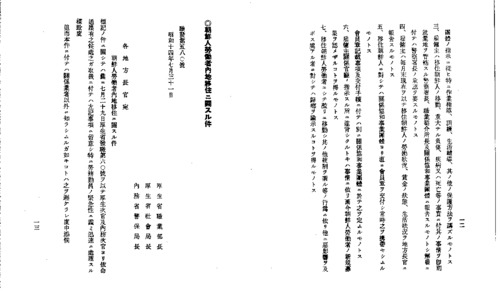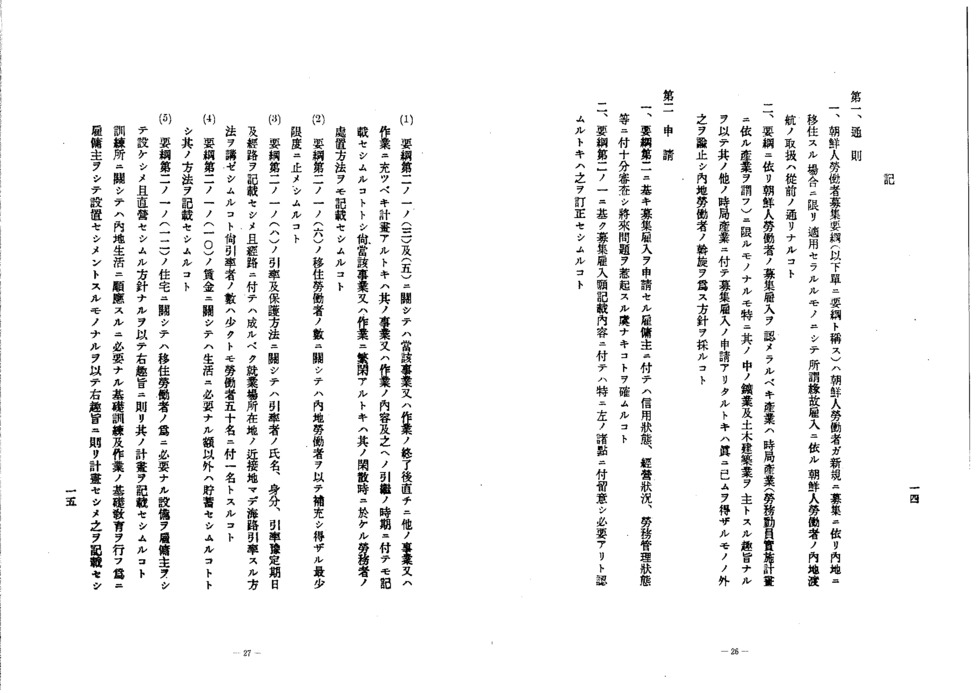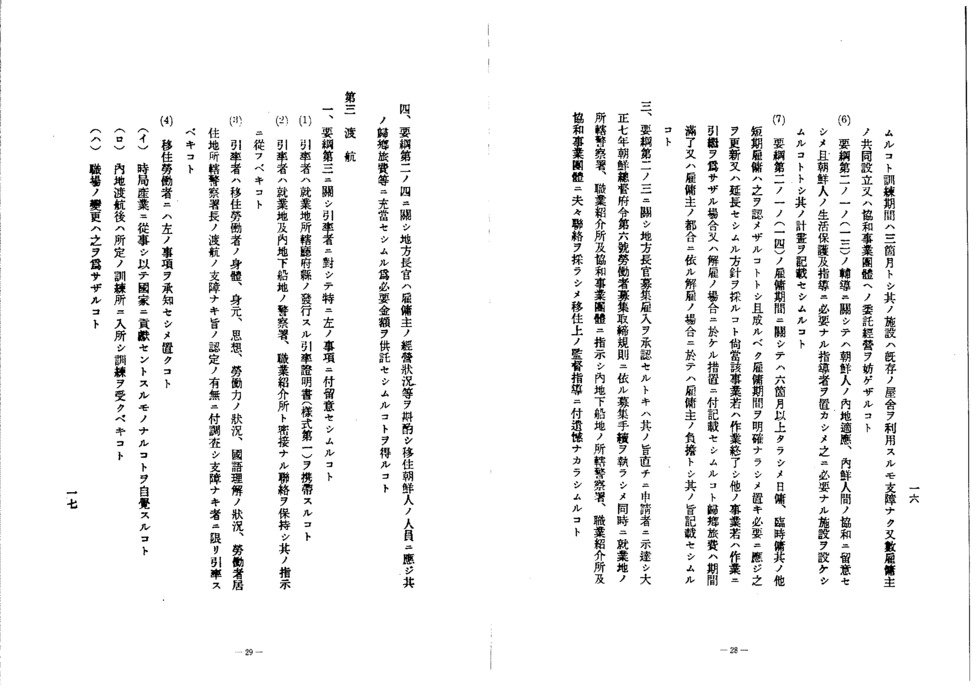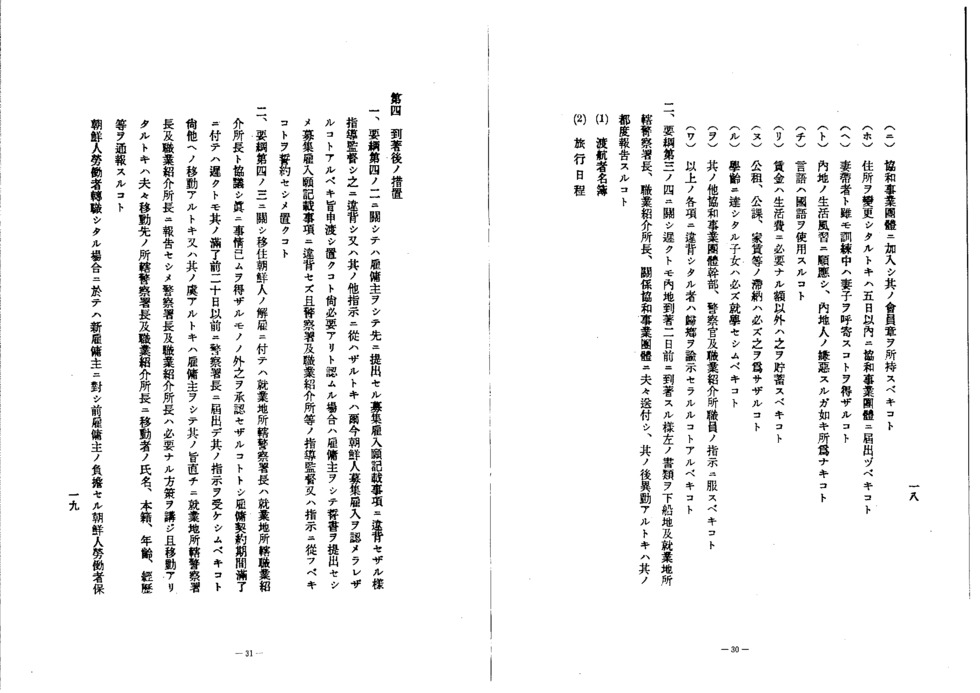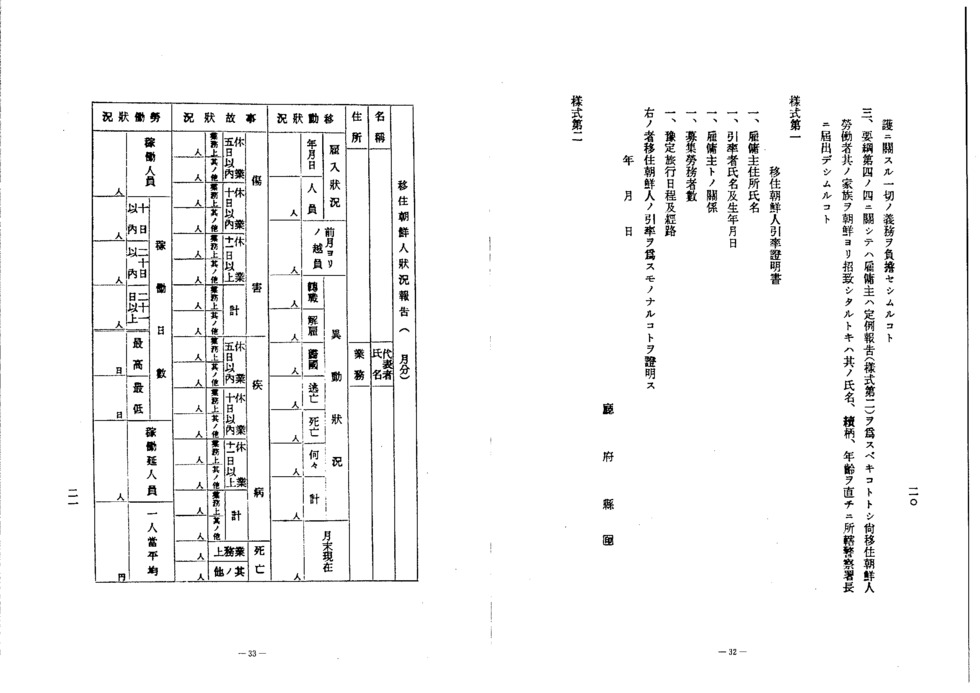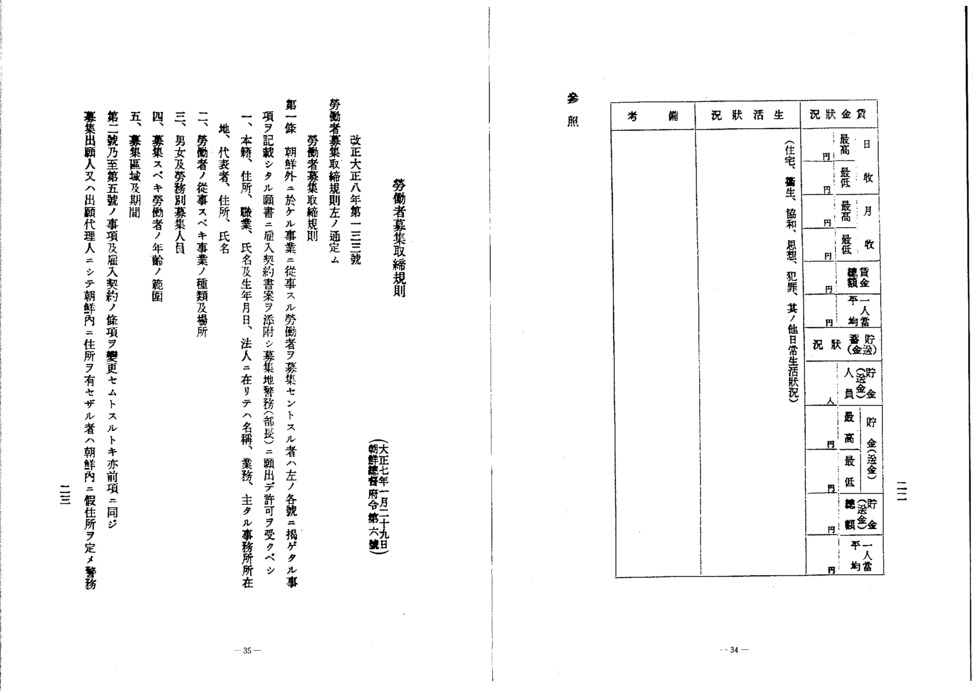Migration of Korean Laborers to Japan
In accordance with the 1939 Labor Mobilization Plan enforcement, Korean laborers were to be brought into Japan proper through recruitment by individual companies; the Ministry of Health and Welfare and the Home Ministry issued this document to notify prefectural governors about the recruitment applications and measures to be taken after travel and employment as regulated in “Guidelines for Recruitment of Korean Laborers.”
- Author
Page 1
Page 2
Page 3
Page 4
Page 5
Page 6
◎ Migration of Korean Laborers to Japan
Dept. of Employment No. 580
July 31, 1939
Director, Department of Employment, Ministry of Health and Welfare
Director, Social Bureau, Ministry of Health and Welfare
Director, Bureau of Police and Public Security, Home Ministry
To: Prefectural Governors
Migration of Korean Laborers to Japan
In accordance with Ministry of Health and Welfare Dept. of Employment No. 60, issued previously on July 29, the Vice-Ministers of Health and Welfare and of Home Affairs request that the following matters be addressed particularly swiftly when handling the subject of this notice, in consideration of the urgency of labor mobilization.
Kindly refrain from informing extraneous personnel of the content of this notification.
- General rules
1) The Guidelines for Recruitment of Korean Laborers (hereinafter referred to simply as the Guidelines) apply only to the migration of Korean laborers to Japan proper for new recruitment; the handling of this migration based on so-called hiring through connections is to continue as so far.
2) According to the Guidelines, the industries for which recruitment and employment of Korean laborers is permitted are limited to wartime industries (as indicated in the Labor Mobilization Plan); this refers in particular to the mining and civil engineering/construction industries. Other wartime industries, except in unavoidable cases, are to refrain from application and adopt the policy of finding Japanese laborers for employment.
- Application
1) Regarding employers submitting applications for recruitment and employment based on Section 2 of the Guidelines, conduct a thorough inspection of their reliability, operating status, labor management status, etc. and confirm that there are no concerns about future problems.
2) Regarding the content of the request for recruitment and employment based on Section 2-1 of the Guidelines, pay particular attention to the following points and have corrections made as necessary.
(1) Regarding Sections 2-1-(3) and 2-1-(5) of the Guidelines, in the case of planing to move workers to a different project or task when the original project or task is complete, make sure that the application also includes the second project or task and the reassignment period; when the relevant project or task fluctuates in intensity, make sure that the application includes measures on handling workers during slack periods.
(2) With regard to the number of migrating laborers, based on Section 2-1-(6) of the Guidelines, the number is to be kept to the minimum which cannot be filled with Japanese laborers.
(3) With regard to guiding and protection methods as indicated in Section 2-1-(8) of the Guidelines, make sure that the application includes the name and rank of the guides as well as the schedule and route of the guided travel. With regard to the route, the closest marine route to the location of employment should be attempted. In addition, the number of guides should be at least one per fifty laborers.
(4) With regard to wages as in Section 2-1-(10) of the Guidelines, amounts beyond the necessary funds for daily life are to be put into savings, and the method for doing so is to be indicated.
(5) With regard to housing described in Section 2-1-(11) of the Guidelines, the employer is to establish the facilities required by the migrant workers and to manage them directly, and the application must include a plan to this end.
The employer is to establish a training center and conduct the necessary basic training for life in Japan as well as basic work education, including the plan therefor in the application. The training period shall be three months. The employer may use existing facilities for training, establish training facilities jointly with other employers, or contract a cultural harmony organization.
(6) With regard to guidance as outlined in Section 2-1-(13) of the Guidelines, attention is to be paid to the Koreans’ adaptation to life in Japan and harmony with Japanese workers; a supervisor is to be appointed to protect and guide them in daily life as needed, with facilities established as required likewise. The application must include a plan to this end.
(7) With regard to the employment period specified in Section 2-1-(14) of the Guidelines, it is to be at least six months, with day labor and other temporary employment not permitted. In addition, the employment period is to be made as clear as possible, with renewals or extensions possible. Also, if laborers are not to be reassigned, or are to be dismissed, when the current project or task is finished, the measures therefore must be indicated in the application. Travel fares home to Korea at the end of the employment period or upon dismissal at the employer’s convenience are to be borne by the employer, as the application must indicate.
3) Regarding Section 2-3 of the Guidelines, when prefectural governors approve recruitment and employment, they are to notify applicants immediately and have them conduct recruitment proceedings based on the Korea Government-General Ordinance No. 6 of 1918, “Laborer Recruitment Control Regulations.” At the same time, they are to direct police stations, placement agencies, and cultural harmony organizations responsible for the employment location to contact their counterparts responsible for the port where the laborers will make landfall and have them thoroughly supervise and guide the laborers’ migration.
4) Regarding Section 2-4 of the Guidelines, prefectural governors may take into account employers’ operating status and have them deposit the amount required for the Koreans’ travel fare home, in accordance with their numbers.
- Migration
1) Regarding Section 3 of the Guidelines, attention is required to the following points concerning travel guides.
(1) The guides are to bear guiding certificates (format 1) issued by the prefecture of the employment location.
(2) The guides are to remain in close contact with the police stations and placement agencies responsible for the employment location and place of landfall in Japan, and to follow their directions.
(3) Guides are to investigate the migrating laborers’ bodies, identification, ideologies, capacity to work, degree of understanding of Japanese, and permission to migrate from the police chief with jurisdiction over their residential location, and to escort only those with no concerns.
(4) Migrating laborers are to comply with the following items.
(a) As employees of a wartime industry, they must be aware that they are contributing to the nation.
(b) After travel to Japan, they must receive training at their assigned training center.
(c) They may not change workplaces.
(d) They must become card-carrying members of a cultural harmony association.
(e) When changing addresses, they must notify the cultural harmony association within five days.
(f) Married laborers may not summon their wives and children during the training period.
(g) They must adapt to Japanese life and customs and refrain from behavior unpleasant to the Japanese.
(h) The language they use is to be Japanese.
(i) After the necessities of life are paid for, the remainder of their wages is to be put into savings.
(j) They must never be in arrears with taxes and public dues or with rent.
(k) They must send any school-age children to school.
(l) They must obey the orders of officials of other cultural harmony associations, police officers, and placement agency staff.
(m) Those failing to comply with any of the points above will be instructed to return to their homeland.
2) Regarding Section 3-4 of the Guidelines, the documents indicated below are to be submitted to the police chiefs, placement agency directors, and relevant cultural harmony associations with responsibility for the place of landfall and the employment location at least two days before arrival in Japan. Any changes of location thereafter are to be reported each time.
(1) List of migrants
(2) Travel schedule
- Measures after arrival
1) Regarding Section 4-2 of the Guidelines, the employer must be supervised and guided so as not to violate the items in the recruitment and employment request submitted in advance. They are to be notified that in the case of violation, or of failure to comply with other directions, any future recruitment and employment of Koreans will not be permitted. In addition, when considered necessary, the employer is to submit a pledge not to violate the items in the recruitment and employment request, and to promise to comply with guidance, supervision, or directions from the police station, placement agency, et cetera.
2) Regarding Section 4-3 of the Guidelines, upon dismissal of migrant Koreans, the employer is to confer with the police chief or placement agency director responsible for the employment location and obtain their admission that no other option is possible; the police chief is to be notified in writing for directions at least twenty days before the end of the employment contract period.
In addition, when moving or likely to move to another location, the employer must immediately report as much to the police chief and placement agency director of the employment location, who must take the required measures and, upon relocation, notify their counterparts at the destination of the names, official domiciles, ages, and histories of those relocating.
When Korean laborers change jobs, their new employers are responsible for all duties with regard to the protection of Korean laborers previously borne by the former employer.
3) Regarding Section 4-4 of the Guidelines, the employer is to submit regular reports (format 2). In addition, when resident Korean laborers summon their families from Korea, their names, relationships, and ages are to be submitted immediately to the responsible police chief.
Format 1
Certificate as a Guide for Migrant Koreans
-- Employer’s name and address
-- Guide’s name and date of birth
-- Relationship with employer
-- Number of recruited workers
-- Travel schedule and route
The person named above is certified as a guide for migrant Koreans.
Date
Prefectural Seal
Format 2
(Format 2 omitted)


